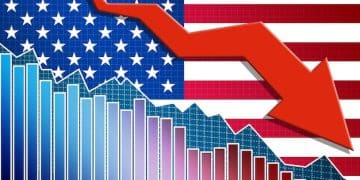US Corporate Tax Rate 2025: Impact on Business Investment

The newly proposed corporate tax rate for 2025 in the United States presents a complex picture for business investments, with potential shifts in capital allocation and strategic planning.
As 2025 approaches, a crucial question arises for executives, investors, and economists alike: is the new corporate tax rate impacting US business investments in 2025? This inquiry delves into the intricate relationship between fiscal policy and corporate behavior, aiming to discern how proposed changes might reshape the American economic landscape. Understanding these dynamics is essential for strategic planning and informed decision-making.
Understanding the Proposed Corporate Tax Rate for 2025
The discussion around the 2025 corporate tax rate isn’t merely about a number; it's about its potential ripple effects across the economy. Policymakers often adjust corporate tax rates with specific goals in mind, such as stimulating growth, redistributing wealth, or addressing budgetary concerns. For 2025, various proposals have emerged, each carrying distinct implications for how businesses operate and invest within the United States.
Examining these proposals requires a look at their historical context. Past tax reforms, like the Tax Cuts and Jobs Act of 2017, significantly altered the corporate tax landscape, leading to debates about their effectiveness in boosting investment and wages. The current considerations for 2025 aim to build upon or pivot from these previous frameworks, reflecting evolving economic philosophies and immediate government priorities.
Historical Context of US Corporate Taxation
The history of corporate taxation in the US is marked by frequent adjustments reflecting economic realities and political ideologies. From peak rates in the mid-20th century to the significant reduction in 2017, each change has sought to influence economic behavior.
- Post-World War II Era: High corporate tax rates, often exceeding 50%, were common, partially to fund government programs and manage post-war debt.
- Reagan Era Reforms: The 1980s saw significant cuts, aimed at promoting supply-side economics and stimulating business growth.
- 2017 TCJA: A drastic drop from 35% to 21% under the Trump administration, intended to make the US more competitive globally and encourage domestic investment.
Understanding this trajectory helps in appreciating the nuanced effects any new rate might have. Businesses historically adapt to these fiscal shifts, sometimes by reallocating capital, other times by altering their operational structures. The proposed 2025 rate, therefore, is not an isolated event but part of a continuous evolution.
The specifics of the 2025 proposals often involve not just the headline rate but also changes to deductions, credits, and international tax rules. These details can be as impactful as the rate itself, influencing everything from research and development spending to decisions about where to locate new facilities. Corporate leaders are meticulously analyzing these fine prints to model various scenarios for their investment strategies.
Direct Impacts on Corporate Investment Decisions
The most immediate question regarding a new corporate tax rate centers on its direct influence on how and where companies choose to invest their capital. Investment decisions are complex, driven by factors ranging from market demand and technological advancements to regulatory environments and, crucially, the cost of doing business. Tax rates directly affect the after-tax profitability of an investment, making them a significant consideration.
When corporate taxes increase, the net return on an investment decreases, potentially making some projects less attractive. This can lead companies to rethink expansion plans, delay new ventures, or even consider shifting investments to jurisdictions with more favorable tax regimes. Conversely, lower tax rates can enhance profitability, incentivizing greater capital expenditure and innovation.
Capital Expenditure and Expansion
One of the primary areas impacted by tax rates is capital expenditure (CapEx). This includes investments in plants, equipment, technology, and infrastructure. Businesses analyze the expected returns on these investments, and an altered tax rate can significantly shift the break-even point or the attractiveness of a project.
- Higher Rates: May lead to reduced CapEx as projects become less profitable post-tax, potentially slowing innovation and job creation.
- Lower Rates: Could encourage greater CapEx, fostering growth, productivity, and job expansion as more projects meet profitability thresholds.
The aggregate effect of many companies adjusting their CapEx can have a profound impact on national economic growth and competitiveness. Policymakers carefully weigh these factors, balancing revenue needs with the desire for a vibrant, growing economy.
Another crucial element is how tax policy affects earnings retention and reinvestment. Companies often retain a portion of their earnings to fund future investments. A higher tax burden on these earnings might reduce the pool of capital available for reinvestment, or it might make distributing earnings to shareholders more appealing than using them for internal growth projects. This balance between dividend payouts and retained earnings for investment is a constant strategic consideration for corporate boards.

The types of investments also matter. Some tax proposals differentiate between types of income or types of businesses, offering incentives for certain activities like research and development (R&D) or manufacturing. Such targeted tax policies can steer investments toward specific sectors deemed strategically important for the nation’s future economic resilience and competitiveness.
Secondary Market Reactions and Investor Confidence
Beyond the direct impact on corporate decision-making, changes in the corporate tax rate often trigger significant reactions in financial markets. Investor confidence is inherently linked to the perceived profitability and stability of businesses. A shift in tax policy can alter this perception, leading to movements in stock prices, bond yields, and overall market sentiment.
Equity markets, in particular, are highly sensitive to corporate profitability. When tax rates change, the market quickly recalculates future earnings expectations, which in turn influences stock valuations. This immediate market reaction can create a feedback loop, further influencing corporate behavior. For instance, a sharp decline in stock prices following a tax announcement might pressure companies to cut costs or reduce investment plans, even if the direct tax impact on their operations is manageable.
Stock Market Volatility and Valuations
Tax policy significantly influences corporate net income, which directly feeds into earnings per share (EPS), a key metric for stock valuation. Changes to the corporate tax rate can prompt reassessments of stock values across industries.
- Reduced Profitability: Higher taxes can lead to lower EPS, potentially driving down stock prices and increasing market volatility.
- Enhanced Profitability: Lower taxes typically boost EPS, which can propel stock prices upward and stabilize markets.
These market swings can also affect a company's ability to raise capital. A company with a strong stock performance might find it easier and cheaper to issue new equity to fund expansion, whereas one facing market headwind due to tax concerns might struggle. This dynamic adds another layer of complexity to investment decisions in a changing tax environment.
Bond markets also react, particularly regarding corporate bonds. If a tax increase is perceived to weaken a company's financial health, its bond ratings might be downgraded, increasing its borrowing costs. Conversely, a favorable tax environment might improve a company's creditworthiness. These changes in financing costs can significantly impact a company's willingness and ability to undertake large-scale investments.
Investor confidence, while somewhat subjective, is a powerful force. If investors collectively believe that a new tax regime will foster economic growth and corporate success, they are more likely to commit capital, even if individual tax liabilities shift. Conversely, uncertainty or perceived detriment can lead to capital flight. This psychological component of market reaction is as crucial as the quantitative analysis in determining the overall impact of tax rate changes.
Impact on Specific Sectors and Business Sizes
Not all businesses or economic sectors feel the effects of a corporate tax rate change equally. The precise impact can vary significantly depending on a company’s capital intensity, profitability, international scope, and even its legal structure. Understanding these nuances is critical for a comprehensive analysis of the 2025 tax landscape.
For example, capital-intensive industries like manufacturing or infrastructure development, which rely heavily on large, long-term investments, might be more sensitive to changes in depreciation rules or investment tax credits that often accompany broader tax reforms. Similarly, businesses with significant international operations could be heavily influenced by how the new tax rate interacts with global tax agreements and anti-avoidance rules.
Technology and Innovation Sector
The technology sector, often characterized by high R&D spending and intellectual property, has unique sensitivities to tax policy. Many tech companies are highly profitable but also require continuous investment in innovation to maintain their competitive edge.
- R&D Credits: The availability and generosity of R&D tax credits can be more impactful than the headline rate for tech companies, incentivizing innovation regardless of the basic corporate tax.
- Global Profit Repatriation: Rules concerning the taxation of foreign earnings are critical for multinational tech giants, affecting their decision to bring profits back to the US for reinvestment.
Small and medium-sized enterprises (SMEs) represent another distinct category. While many SMEs are structured as pass-through entities (e.g., S-corporations, partnerships, LLCs) and thus pay taxes at the individual owner level rather than corporate rates, some are C-corporations and would be directly affected. For these C-corp SMEs, a tax increase could limit their ability to reinvest profits, hire new employees, or expand operations, disproportionately impacting their growth trajectory compared to larger, more diversified corporations.

Furthermore, industries facing stiff international competition, such as manufacturing or certain service exports, might experience enhanced or diminished competitiveness depending on how the US corporate tax rate compares to those of other major economies. A higher domestic tax rate could make US-based production less attractive, potentially driving businesses to relocate or expand operations overseas.
Potential Economic Ripple Effects
The effects of a new corporate tax rate extend far beyond corporate balance sheets; they ripple through the broader economy, influencing employment, wages, consumer spending, and even government revenue. These macroeconomic impacts are what policymakers typically target when designing tax reforms, but their realization can be complex and indirect.
One major consideration is job creation. If a tax increase reduces corporate profitability and investment, companies might slow hiring or even reduce their workforce. Conversely, a tax cut that stimulates investment could lead to more jobs. Wages are also influenced; some theories suggest that lower corporate taxes could translate into higher wages for workers as companies have more capital to invest in human talent and productivity-enhancing technologies.
Impact on Wages and Employment
The “incidence” of the corporate tax—who ultimately bears its cost—is a subject of ongoing debate among economists. Some argue that a significant portion of the tax burden falls on workers through lower wages or fewer job opportunities, while others contend it primarily affects shareholders and consumers.
- Labor Demand: If corporate taxes reduce the profitability of new investments, companies may hire fewer workers or offer lower wages.
- Productivity: Investments in technology and infrastructure often boost worker productivity. If such investments decline due to higher taxes, long-term wage growth could be constrained.
Government revenue is another direct consequence. While a higher tax rate might intuitively suggest more tax receipts, the relationship isn’t always linear. If a higher rate significantly reduces economic activity or incentivizes tax avoidance, the actual revenue collected might fall short of projections. This “Laffer curve” concept suggests there's an optimal tax rate that maximizes government revenue without stifling economic growth.
Consumer spending, a major driver of the US economy, can also be indirectly affected. If corporate investment leads to more jobs and higher wages, consumers have more disposable income, potentially boosting demand for goods and services. Conversely, a slowdown in corporate activity could lead to reduced consumer confidence and spending. These interconnected effects make predicting the exact macroeconomic outcome of a tax change challenging.
Finally, international competitiveness comes into play. If the US corporate tax rate becomes significantly higher or lower than that of other major economies, it can influence capital flows, attracting foreign investment or discouraging domestic companies from expanding at home. This global dimension adds another layer of complexity to the 2025 tax debate, as policymakers aim to balance domestic needs with global economic realities.
Future-Proofing Strategies for US Businesses
In anticipation of potential shifts in the corporate tax landscape for 2025, US businesses are not merely waiting to react; many are actively developing future-proofing strategies. This proactive approach involves a combination of financial planning, operational agility, and strategic foresight to mitigate risks and capitalize on new opportunities.
One key strategy involves scenario planning. Companies are modeling various potential tax outcomes, from moderate increases to more significant changes, and assessing their financial implications. This allows them to identify potential vulnerabilities and stress-test their business plans under different tax regimes. By understanding the potential impact now, they can develop contingency plans and adjust their strategies accordingly.
Diversification of Investment Portfolio
To reduce dependence on any single jurisdiction or tax environment, companies often consider diversifying their investment portfolios both geographically and by asset class. This can mean expanding into new markets or exploring different types of investments.
- Geographic Diversification: Investing in regions with stable or favorable tax policies can balance out potential negative impacts in the US.
- Asset Diversification: Spreading investments across various asset types (e.g., real estate, technology, financial instruments) can hedge against sector-specific tax changes.
Another crucial strategy is optimizing capital structure. Businesses are reviewing their debt-to-equity ratios and considering how changes in the tax deductibility of interest expenses might affect their financing costs. Given that interest payments are typically tax-deductible, a higher corporate tax rate could make debt financing relatively more attractive, assuming deductibility remains intact. Companies are carefully re-evaluating these trade-offs to ensure their capital structure remains efficient.
Operational efficiency and cost control are ever-present priorities, but they gain renewed importance in a shifting tax environment. Businesses are looking for ways to streamline operations, reduce waste, and leverage technology to improve productivity. These measures can bolster profitability and help absorb any increase in tax burden without resorting to cuts in investment or staffing.
Finally, engaging in proactive tax planning with expert advisors is essential. This includes understanding the nuances of proposed legislation, identifying eligible deductions and credits, and structuring transactions in a tax-efficient manner. Companies are also evaluating changes in accounting standards and their interplay with tax rules to ensure full compliance and optimal financial reporting. By adopting these multi-faceted strategies, US businesses aim to navigate the evolving tax landscape of 2025 with resilience and sustained growth.
| Key Point | Brief Description |
|---|---|
| 💰 Tax Rate Changes | Proposed higher corporate tax rates for 2025 could lower after-tax profitability for businesses. |
| 🏗️ Investment Impact | Higher taxes may reduce capital expenditures and disincentivize domestic business expansion. |
| 📈 Market Response | Financial markets, especially stocks, react sensitively to tax changes, affecting investor confidence. |
| 🛡️ Strategic Adaptation | Businesses develop strategies like scenario planning and operational efficiency to navigate tax changes. |
Frequently Asked Questions About 2025 Corporate Tax Rates
A higher corporate tax rate for C-corporations could impact small businesses by reducing their retained earnings, thus limiting funds available for reinvestment in growth, technology, or hiring. Many small businesses are structured as pass-through entities, meaning their owners pay taxes at individual rates, not corporate. However, those structured as C-corps would feel the direct impact, potentially slowing their capacity for expansion.
The new corporate tax rate could primarily influence foreign direct investment (FDI) in the US based on its competitiveness relative to other major economies. A higher rate might make the US less attractive for new foreign investment, potentially diverting capital elsewhere. Conversely, if accompanied by other incentives or a stable economic environment, the impact might be softened, but direct profitability is a key driver for FDI decisions.
The impact on consumer prices and inflation from a new corporate tax rate is complex and debated. Some economists argue that corporations might pass on higher tax burdens to consumers through increased prices, contributing to inflation. Others suggest that the tax burden largely falls on shareholders or workers. The ultimate effect depends on market competition, elasticity of demand, and the overall economic landscape.
Tax credits and deductions play a crucial role in the effective corporate tax rate, often reducing the actual amount of tax paid even if the headline rate rises. Policymakers frequently adjust these provisions to incentivize specific behaviors, such as research and development or domestic manufacturing. Businesses closely examine these additional rules, as they can significantly alter the net financial impact of a new tax rate.
Lobbying efforts from various industry groups and large corporations are expected to play a significant role in shaping the final 2025 tax rate. These groups advocate for their specific interests, aiming to influence the rate, deductions, and credits in ways that benefit their sectors. Their input can lead to compromises and adjustments in legislative proposals, reflecting the diverse priorities and concerns across the business community.
Conclusion
The discussions surrounding the 2025 corporate tax rate underscore its profound potential to reshape the US business landscape. From directly influencing investment decisions and capital expenditures to sending ripple effects through financial markets and various economic sectors, the eventual policy will be a critical determinant of economic activity. While uncertainties remain, businesses are proactively developing strategies to adapt, demonstrating resilience in navigating fiscal changes. The precise impact will ultimately hinge not just on the headline rate, but also on the accompanying provisions and the broader economic context, requiring continuous monitoring and strategic agility from all stakeholders.





